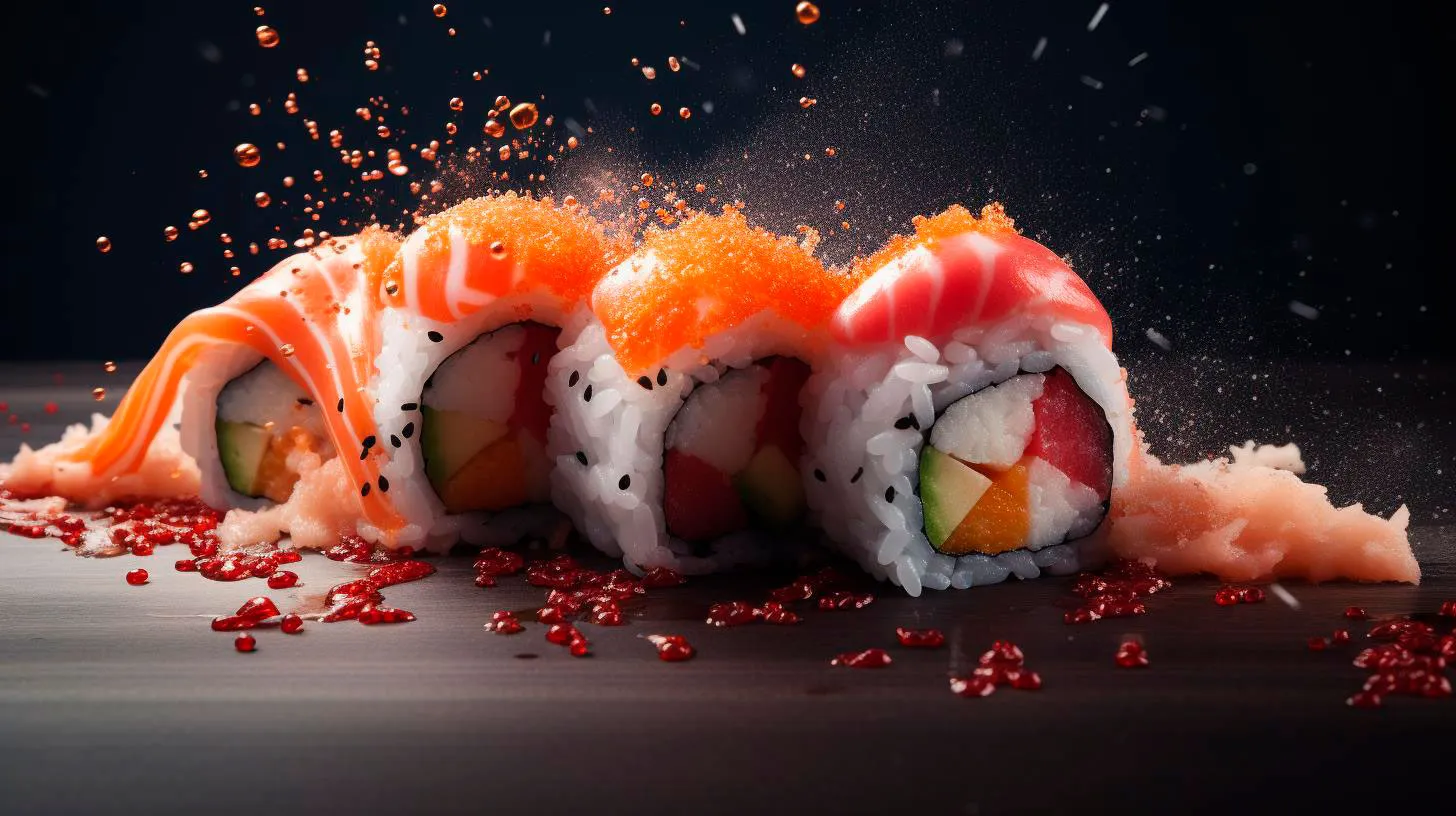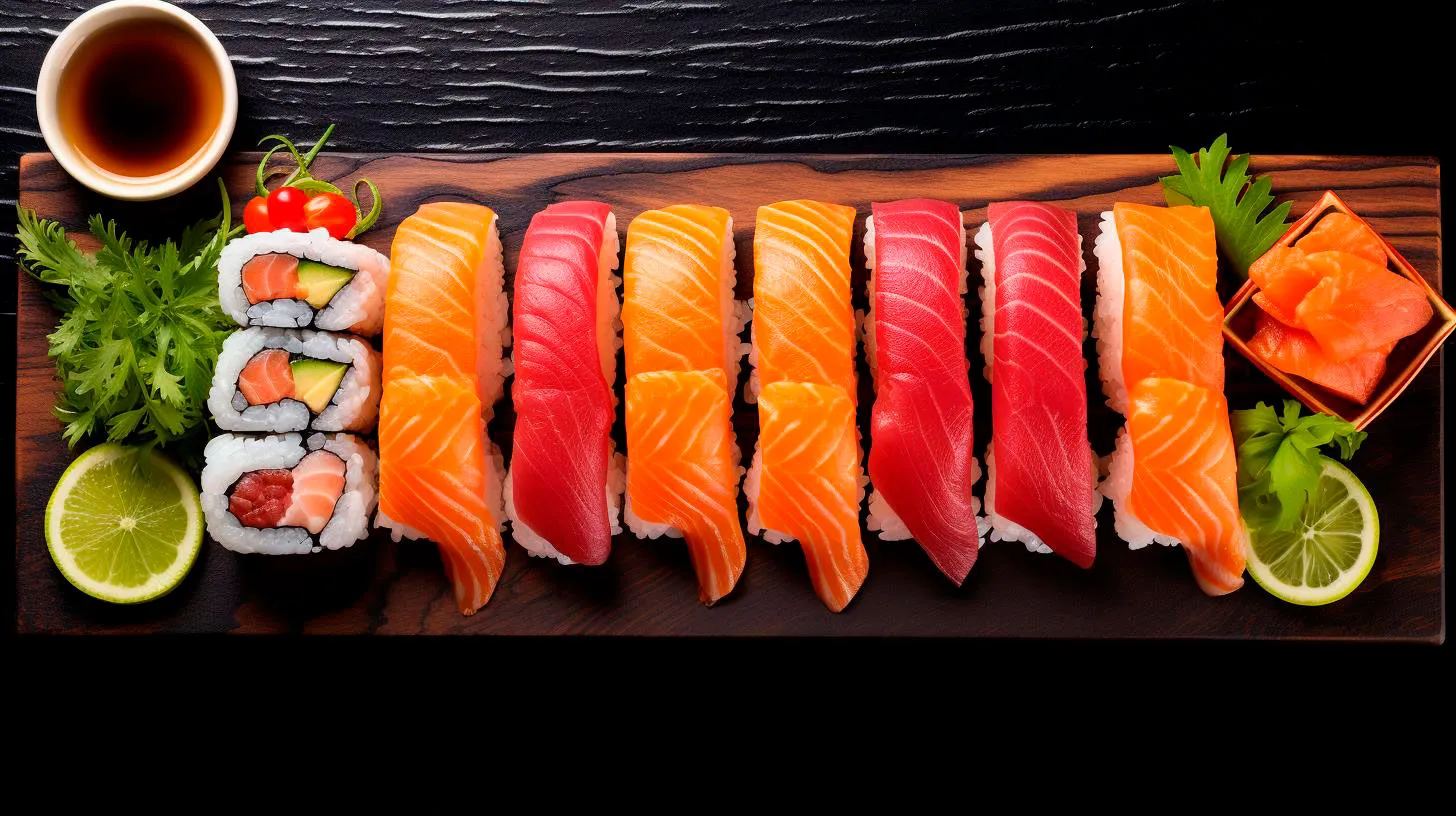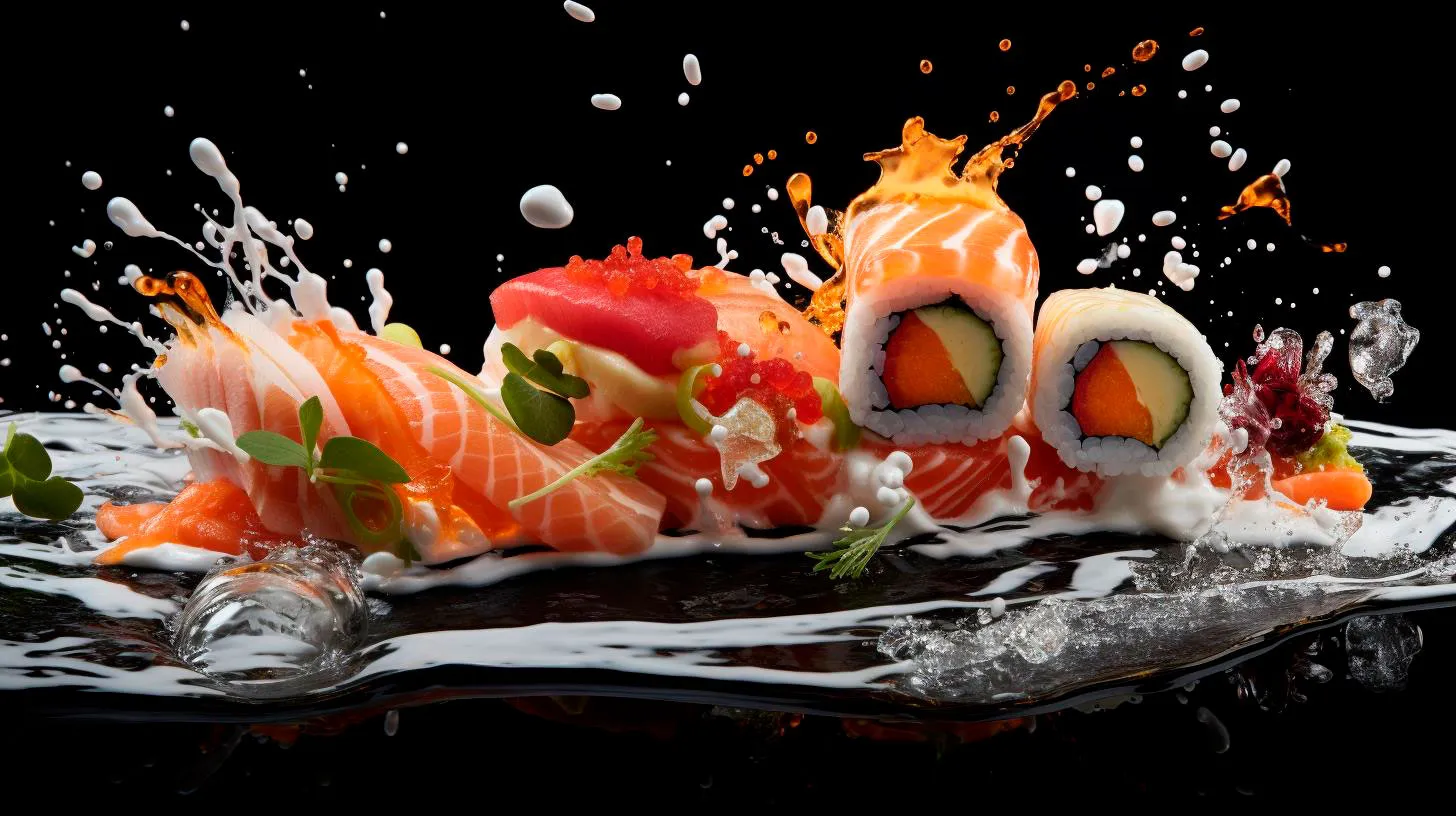Cultural Perspectives: Sushi Allergies Beyond Borders
In this article, we will explore the cultural perspectives surrounding sushi allergies beyond borders and highlight the importance of understanding and accommodating these dietary restrictions.
The Allergy Epidemic
Allergies have become a global health concern, affecting millions of people worldwide. According to recent statistics, food allergies affect up to 8% of children and 4% of adults globally. With the growing popularity of sushi, it is crucial to address the potential risks associated with consuming raw fish and seafood.
Japan: The Birthplace of Sushi
In Japan, sushi is deeply rooted in tradition and culture. It is an art form that requires years of apprenticeship to master. However, when it comes to allergies, Japan has been slow to adapt. While sushi chefs are highly skilled at creating delicious and visually appealing dishes, there is often a lack of understanding regarding food allergies and cross-contamination.
Key Takeaway: When dining in Japan, it is essential to communicate any food allergies or dietary restrictions clearly. Do not assume that the chef will automatically be aware of your specific requirements.
United States: Fusion and Allergy Awareness
In the United States, sushi has evolved into a fusion of flavors, incorporating various ingredients and cooking styles. With the rise of food allergies, American sushi restaurants have taken steps to accommodate customers with dietary restrictions. Many establishments now offer allergy-friendly menu options, clearly labeling allergens such as shellfish, soy, and gluten.
Key Takeaway: If you have allergies, the United States offers a more allergy-aware dining experience. Look for sushi restaurants that provide clear information on allergens and options for customization.
Europe: Embracing Diversity
Europe has a diverse culinary scene when it comes to sushi. From traditional Japanese establishments to trendy fusion restaurants, Europe offers a range of sushi experiences. However, in terms of allergy awareness, Europe still has room for improvement. Different countries have varying levels of understanding and catering to allergies, so it is crucial to do your research before dining out.
Key Takeaway: When exploring sushi in Europe, be proactive in informing the staff about your allergies. Always ask about ingredient lists or potential cross-contamination risks.
The Importance of Allergy Education
As sushi continues to transcend borders, it is vital for both consumers and sushi chefs to prioritize allergy education. By fostering a greater understanding of allergies and cross-contamination risks, we can create a safer and more inclusive dining experience for everyone.
Consumer Empowerment
As a sushi lover with allergies, it is essential to be proactive and informed. Here are some key steps you can take to ensure a safe dining experience:
- Research sushi restaurants in advance and read reviews from others with similar dietary restrictions.
- Communicate your allergies clearly to the staff, including specific ingredients to avoid.
- Ask about cross-contamination risks and how the restaurant handles allergen separation.
- Consider bringing allergy cards written in the local language to effectively communicate your allergies.
Chef Training and Awareness
Sushi chefs are the creators of these culinary delights, and their knowledge and awareness are crucial. Here are ways in which sushi chefs can enhance their allergy education and provide an inclusive experience:
- Attend allergy awareness workshops or training sessions to understand common allergies and their implications.
- Implement proper cross-contamination prevention techniques in the kitchen.
- Clearly label allergens on menus and educate staff to handle allergy inquiries appropriately.
Culinary Adventure with Allergen Safety
Sushi is not only a delicious food choice but also a cultural experience. By embracing allergen safety, we can ensure that everyone, regardless of their dietary restrictions, can indulge in this culinary adventure.
Remember, when it comes to sushi allergies beyond borders:
- Japan’s traditional sushi scene may have limited allergy knowledge, so be clear about your requirements.
- The United States offers allergy-friendly options and clear labeling of allergens.
- Europe’s sushi scene varies, so research and communication are key to a safe dining experience.
Let’s continue to learn, adapt, and embrace cultural perspectives, making sushi accessible to all.
Cultural Perspectives on Sushi Allergies in Europe
One such challenge is the prevalence of sushi allergies, particularly in Europe. In this article, we will explore the cultural perspectives surrounding sushi allergies in Europe, discussing both the challenges and opportunities they present.
The Rise of Sushi Allergies in Europe
In recent years, the occurrence of sushi allergies has increased significantly in Europe. This rising trend can be attributed to various factors, including changes in dietary habits, awareness of food allergies, and the globalization of culinary practices. According to recent statistics:
- In the United Kingdom alone, the number of people diagnosed with fish and shellfish allergies has risen by 76% over the past decade.
- In Germany, fish allergies have become the most common food allergy, affecting approximately 5% of the population.
- In France, there has been a 30% increase in reported cases of sushi-related allergies.
These statistics highlight the escalating issue of sushi allergies in Europe and the need for a deeper understanding of the cultural aspects influencing this phenomenon.
Cultural Perspectives on Sushi Allergies
1. Differences in Culinary Practices
Europe has a rich culinary heritage, with many traditional dishes featuring locally sourced ingredients. The introduction of sushi to the continent has challenged these long-established practices. Sushi represents a distinct departure from European culinary norms, with its emphasis on raw fish and seafood. This contrast has led to a clash of cultures, as Europeans adapt to a new way of consuming seafood. Some cultural perspectives to consider include:
- Preference for cooked seafood: Many Europeans have a preference for cooked seafood, which reduces the risk of allergic reactions. The consumption of raw fish in sushi goes against this cultural preference.
- Concerns over food handling: Europeans often prioritize food safety and hygiene. The preparation methods of sushi, which involve raw fish, can sometimes raise concerns about potential health risks.
- Vegetarian and vegan options: European countries have a higher percentage of vegetarians and vegans compared to other regions. Sushi restaurants have started offering plant-based options to cater to these dietary preferences.
2. Allergy Awareness and Education
Allergy awareness and education play a significant role in managing sushi allergies in Europe. As people become more aware of common food allergies, including fish and shellfish, they are more cautious about consuming sushi. Some key takeaways regarding cultural perspectives on allergy awareness include:
- The importance of labeling: Clear and accurate labeling is crucial for individuals with allergies. Sushi restaurants in Europe are increasingly providing detailed information about potential allergens in their dishes.
- Communicating allergies to chefs: As sushi becomes more popular, it is essential for individuals with allergies to communicate their dietary restrictions to chefs. This helps create a safer dining experience.
The Future of Sushi Allergies in Europe
As the popularity of sushi continues to grow in Europe, so does the need for managing sushi allergies. Cultural perspectives and practices surrounding sushi consumption will evolve as Europeans adapt to this culinary delight. Some key trends and opportunities for the future include:
- Sushi innovation: Chefs in Europe are exploring creative ways to cater to individuals with sushi allergies. This includes the development of alternative ingredients and preparation techniques.
- Collaboration between cultures: The exchange of culinary practices between Japan and Europe presents an opportunity for cultural understanding and innovation. European chefs can learn from Japanese traditions to create sushi dishes that are more compatible with local tastes and preferences.
- Allergy-friendly sushi restaurants: The demand for allergy-friendly dining experiences is on the rise. Sushi restaurants in Europe can tap into this market by offering dedicated menus and staff trained to handle allergies.
In conclusion, sushi allergies in Europe embody a clash of culinary cultures and present both challenges and opportunities. Understanding the cultural perspectives surrounding sushi consumption, awareness of allergies, and future trends can pave the way for a harmonious relationship between sushi and European palates.
Cultural Perspectives: Sushi Allergies in Japan
In this article, we will explore the unique approach that Japan takes to sushi allergies and delve into the reasons behind it.
The Love Affair with Sushi
Before we dive into sushi allergies, let’s take a moment to appreciate the love affair that Japan has with sushi. According to a survey conducted by Japan’s Ministry of Agriculture, Forestry, and Fisheries, it was estimated that the average Japanese person consumes around 15 kilograms of seafood annually, with a significant portion of that being raw fish in the form of sushi.
Sushi is deeply ingrained in Japanese culture, with its roots dating back to the 9th century. It is an art form that requires meticulous attention to detail and a profound respect for the ingredients. The exquisite presentation and delicate flavors are a testament to the craftsmanship and culinary traditions that have been passed down through generations. However, with such a strong sushi culture, one might wonder how sushi allergies are handled in Japan.
The Unique Perspective on Sushi Allergies
While food allergies are a growing concern in many parts of the world, Japan has a somewhat different approach when it comes to sushi allergies. In Japanese culture, there is a general expectation that individuals should adapt to the existing culinary traditions, rather than the other way around. So how does this perspective apply to sushi allergies?
In Japan, it is uncommon to find sushi restaurants that cater specifically to food allergies. Unlike in some Western countries, where food establishments are required to disclose information about potential allergens, Japanese restaurants often assume that customers are aware of their own dietary restrictions and will take necessary precautions when dining out.
The Japanese Approach to Sushi Allergies
While the lack of specific accommodations for sushi allergies may seem surprising, it is important to consider the cultural factors at play. Here’s a closer look at the Japanese approach to sushi allergies:
- Cultural Expectations: In Japan, there is a strong emphasis on personal responsibility and adaptation rather than expecting others to make accommodations for individual needs.
- Ingredient Communication: In Japanese restaurants, the assumption is that customers will communicate their dietary restrictions directly to the staff, allowing them to modify dishes where necessary.
- Menu Flexibility: Despite the lack of specific allergy-centered menus, many sushi restaurants do offer a wide variety of sushi options, including vegetarian or cooked alternatives that may be suitable for individuals with allergies.
It is worth noting that while the Japanese approach to sushi allergies may differ from practices in other parts of the world, sushi chefs in Japan are highly skilled and knowledgeable individuals. They have a deep understanding of the ingredients they work with and are often more than willing to accommodate dietary restrictions when requested.
Key Takeaways
When it comes to sushi allergies in Japan, there is a unique cultural perspective that prioritizes personal responsibility and adaptation. Here are some key takeaways:
- Japan has a strong sushi culture, with an average person consuming around 15 kilograms of seafood annually.
- Japanese restaurants generally assume that customers will communicate their dietary restrictions directly to the staff.
- While specific accommodations for sushi allergies may be rare, many sushi restaurants offer a variety of options that can suit individuals with different dietary needs.
- Customers should always inform the staff about their allergies to ensure a safe dining experience.
So, the next time you find yourself in Japan exploring the world of sushi, remember the cultural perspective that surrounds sushi allergies. It is a unique aspect of Japan’s culinary scene that highlights the importance of personal responsibility and adaptation within their rich food culture.
Cultural Perspectives: Sushi Allergies in the US
The Rising Popularity of Sushi in the US
According to the latest industry statistics, the sushi market in the US is expected to reach a value of $22.8 billion by 2025, growing at a CAGR of 4.9% from 2020 to 2025. This growth can be attributed to the increasing number of sushi restaurants, the rising demand for ethnic food, and the growing health-consciousness among Americans.
Sushi offers a variety of flavors, from the mild and delicate taste of sashimi to the bold and tangy flavors of rolls with spicy sauces. Its colorful and artistic presentation, featuring fresh fish, vegetables, and rice, is a feast for the eyes. Furthermore, sushi is often perceived as a healthier alternative to fast food, as it typically includes nutrient-rich ingredients like fish, seaweed, and vegetables.
The Allergy Concern: An Unexpected Challenge
With the increasing popularity of sushi, food allergies have become a significant concern within the industry. While most people associate food allergies with common allergens like nuts or dairy, seafood allergies are a serious issue that affects many individuals. In fact, seafood ranks among the top eight most common food allergens in the US, with shellfish allergies being the most prevalent.
For those with seafood allergies, enjoying sushi can be challenging and even life-threatening if not properly addressed. Cross-contamination and mislabeling of ingredients are common issues in restaurants that may unknowingly expose individuals to allergens.
Important Considerations for Sushi Lovers with Allergies
- Carefully Choose Your Sushi Restaurant: Opt for restaurants that offer transparent and detailed menu descriptions. Make it a point to inform the staff about your allergy, ensuring they understand the severity and precautions required.
- Communicate Allergies Clearly: It is essential to communicate your allergy concerns with the staff. Don’t hesitate to ask questions about ingredients and preparation methods to avoid any allergen exposure.
- Double-Check Ingredient Lists: Before ordering any sushi dish, review the ingredient list to ensure it does not contain any allergens. This is especially important for hidden ingredients like fish stock, miso paste, and imitation crab meat, which may contain allergenic substances.
- Beware of Cross-Contamination: Cross-contamination can occur when the same utensils or cutting boards are used for both seafood and non-seafood ingredients. Ensure that the restaurant follows strict hygiene practices to minimize the risk of cross-contamination.
Key Takeaways
As sushi continues to gain popularity in the US, it is important to consider the cultural perspectives surrounding sushi allergies. With seafood allergies ranking among the most common food allergies, individuals with these allergies face unique challenges when enjoying sushi.
By choosing seafood allergy-friendly restaurants, effectively communicating allergies to the staff, and double-checking ingredient lists, sushi lovers with allergies can still enjoy their favorite dishes safely. It is crucial for the industry to address these concerns and implement proper preventive measures to cater to this growing demographic.
So, the next time you indulge in a sushi feast, remember to consider the cultural perspectives and challenges faced by those with allergies. By creating awareness and embracing inclusivity, the sushi industry can continue to grow while ensuring the well-being of all its customers.



